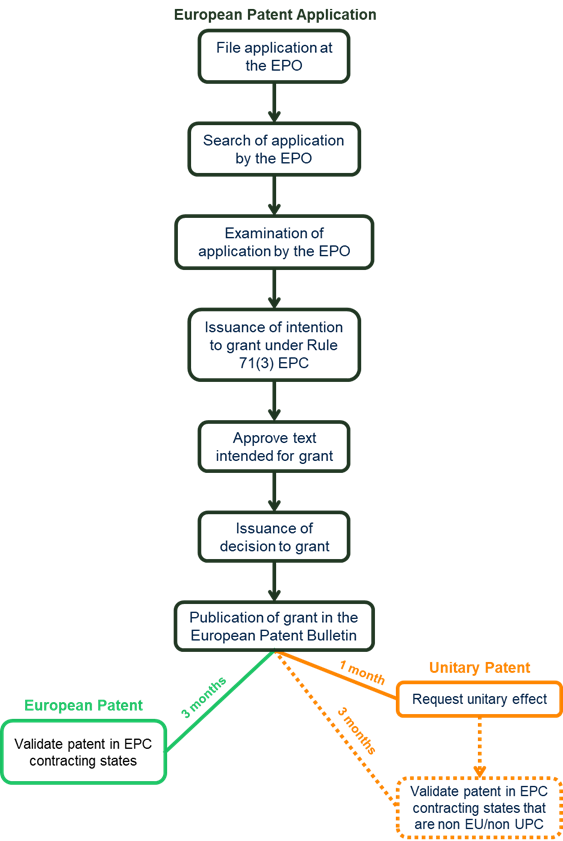The Unitary Patent

The unitary patent (UP) and the Unified Patent Court (UPC) are available for all users of the European patent system. This requires some important decisions regarding to be made regarding European patent applications and European patents. Our Unitary Patent Team at Gill Jennings & Every is here to help you with these important decisions.
How is a unitary patent (UP) different from a European patent?
The existing regional patent system in Europe results in a European patent, granted under the European Patent Convention (EPC).
A European patent is a bundle of national patent rights obtained via a central application procedure at the European Patent Office (EPO). Upon grant of the European patent by the EPO, it is currently necessary to take steps to “validate” the patent in order for it to take effect as a national patent in each of the EPC contracting states in which protection is required, selected from those shown in the map below on the left. This “European” system is still available alongside the unitary patent (UP) system.
A UP is a single patent providing protection in all participating EU member states as shown in the map below on the right. Therefore, applicants will be able to choose to have a UP instead of validating separately in the participating EU member states.
The list of participating EU member states that are covered by a UP could potentially expand to include all of the EU member states – with the exception of Croatia, Poland and Spain, but this may change in the future. The countries included in any one UP will depend on the countries that have completed the legal process to join by the time unitary effect is requested (see below for details for how to obtain a UP).

Source: EPO website 28 March 2022 – https://www.epo.org/law-practice/unitary/unitary-patent.html
Consequently, not all countries that can be covered by a European patent are able to be covered by a UP. For example, a European patent can be validated in the UK, which is a contracting state of the EPC, but the UK will not be covered by a UP as it is no longer a member of the EU.
However, it will be possible to obtain protection from a European patent in countries outside of the UP system by additional separate validation in each country, in parallel, using the current European system. Please see the footnote at the end of this summary for a full list of the countries that can be covered by each of the two systems.
Why a unitary patent?
The main driving force for the introduction of a UP was to provide a significant reduction in costs over the lifetime of a patent. However, whether or not a UP does in fact offer applicants significant cost reductions is largely dependent on the number of countries in which those applicants usually validate your European patents.
A UP has the following important features:
- A single renewal fee will be payable each year, rather than separate fees in respect of each of the UP member states.
- It will not be necessary to meet different post-grant translation requirements for each of the UP member states. Instead, a single translation of the entire patent specification into one other language of an EU member state shall be filed.
- A UP can be licensed in respect of all member states, or only in respect of some member states.
- Most importantly, a UP may only be limited, transferred, revoked, or allowed to lapse in respect of all member states.
- A UP automatically falls under the jurisdiction of the UPC. This has potentially significant consequences on the conduct of patent litigation in Europe. A separate note on the UPC is available.
Obtaining a unitary patent

The procedure for obtaining a UP is very similar to the procedure for obtaining national patent protection from a European patent. In fact, the patent application will still be filed at the EPO, and searched and examined by the EPO, so the procedure up until grant of the application will be identical (see right).
Upon grant of a European patent, it will be necessary to decide whether unitary effect is desired. If the answer is yes, then applicants will need to request to use the UP system within one month of the publication of the mention of grant in the European Patent Bulletin. A translation of the entire patent specification into one other language of an EU member state will also need to be filed during a transitional period.
Litigation of a UP will only be conducted by the Unified Patent Court and not by a national court.
When will it be possible to obtain a unitary patent?
It is possible to obtain a UP for any European patent application granted from 1 June 2023 onwards.
How do I decide what to do next?
To summarise, whether you choose to use the UP system or not will be very dependent on the nature of your business. There is no “one size fits all” approach, so we recommend that you discuss this change in the European patent system with your usual attorney at Gill Jennings & Every. Alternatively, you can contact us here or via gje@gje.com.